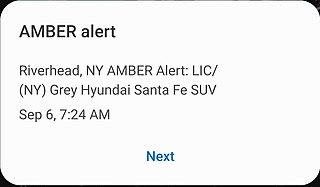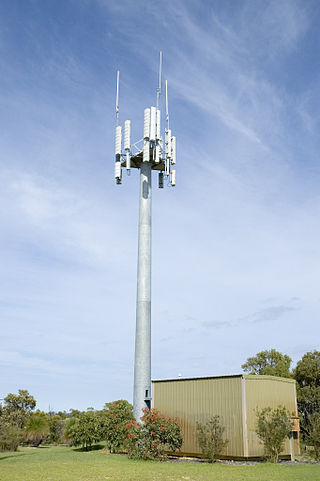Enhanced 911 is a system used in North America to automatically provide the caller's location to 911 dispatchers. 911 is the universal emergency telephone number in the region. In the European Union, a similar system exists known as E112 and known as eCall when called by a vehicle.

An Amber alert or a child abduction emergency alert is a message distributed by a child abduction alert system to ask the public for help in finding abducted children. The system originated in the United States of America.

A pager, also known as a beeper or bleeper, is a wireless telecommunications device that receives and displays alphanumeric or voice messages. One-way pagers can only receive messages, while response pagers and two-way pagers can also acknowledge, reply to, and originate messages using an internal transmitter.

Mobile telephony is the provision of telephone services to mobile phones rather than fixed-location phones. Telephony is supposed to specifically point to a voice-only service or connection, though sometimes the line may blur.

An emergency population warning is a method where by local, regional, or national authorities can contact members of the public to warn them of an impending emergency. These warnings may be necessary for a number of reasons, including:

Cell Broadcast (CB) is a method of sending short messages to multiple mobile telephone users in a defined area at the same time. It is defined by the ETSI's GSM committee and 3GPP and is part of the 2G, 3G, 4G LTE (telecommunication) and 5G standards. It is also known as Short Message Service-Cell Broadcast . Unlike Short Message Service-Point to Point (SMS-PP), Cell Broadcast is a one-to-many geo-targeted and geo-fenced messaging service.
The Standard Emergency Warning Signal (SEWS) is a warning siren used in Australia to alert the public of danger. The siren is played over radio, television or public address systems in public places to warn of bushfire, flood, cyclone, tsunami, earthquake or terrorist attack.
Next Generation 911 refers to an initiative aimed at updating the 911 service infrastructure in the United States and Canada to improve public emergency communications services in a growing wireless mobile society. In addition to calling 911 from a phone, it intends to enable the public to transmit text, images, video and data to the 911 center. The initiative also envisions additional types of emergency communications and data transfer. This NG911 infrastructure is intended to replace the current services over time. The National Emergency Number Association (NENA) first identified the need for NG911 in 2000, and started development actions in 2003, and is nearing full definition and standards for NG911. Since 2006, the US Department of Transportation (DOT) in the United States and the Canadian Radio-television and Telecommunications Commission (CRTC) in Canada have been leading their respective initiatives, which include research and development projects aimed at advancing NG911. On January 24, 2013, the CRTC announced the first step toward a Canadian implementation of NG911 and, in March 2016, began a consultation with the public to discuss what services should be offered, who will play a role in offering these services and how these services should be paid for. Several US states have implemented versions of NG911, as of October 2013.

Wireless Emergency Alerts, is an alerting network in the United States designed to disseminate emergency alerts to mobile devices such as cell phones and pagers. Organizations are able to disseminate and coordinate emergency alerts and warning messages through WEA and other public systems by means of the Integrated Public Alert and Warning System.
The Integrated Public Alert and Warning System (IPAWS) is an architecture that unifies the United States' Emergency Alert System, National Warning System, Wireless Emergency Alerts, and NOAA Weather Radio, under a single platform. IPAWS was designed to modernize these systems by enabling alerts to be aggregated over a network and distributed to the appropriate system for public dissemination.
A connected car is a car that can communicate bidirectionally with other systems outside of the car. This connectivity can be used to provide services to passengers or to support or enhance self-driving functionality. For safety-critical applications, it is anticipated that cars will also be connected using dedicated short-range communications (DSRC) or cellular radios, operating in the FCC-granted 5.9 GHz band with very low latency.
An emergency communication system (ECS) is any system that is organized for the primary purpose of supporting one-way and two-way communication of emergency information between both individuals and groups of individuals. These systems are commonly designed to convey information over multiple types of devices, from signal lights to text messaging to live, streaming video, forming a unified communication system intended to optimize communications during emergencies. Contrary to emergency notification systems, which generally deliver emergency information in one direction, emergency communication systems are typically capable of both initiating and receiving information between multiple parties. These systems are often made up of both input devices, sensors, and output/communication devices. Therefore, the origination of information can occur from a variety of sources and locations, from which the system will disseminate that information to one or more target audiences.
Advanced Mobile Location is a free-of-charge emergency location-based service (LBS) available on smartphones that, when a caller dials the local short dial emergency telephone number, sends the best available geolocation of the caller to a dedicated end-point, usually a Public Safety Answering Point, making the location of the caller available to emergency call takers in real-time. AML improves the time taken by emergency call takers to verify the location of callers and can improve the time taken to dispatch an emergency response.

NL-Alert is a Cell Broadcast alarm system in use by the Dutch government to quickly alert and inform citizens of hazardous or crisis situations. Using this system, authorities can send messages to users of mobile phones in specific areas by using specific cell towers to alert phones within their reach. NL-Alert is one of the first implementations of the EU-Alert or Reverse 1-1-2 legislation as defined by the binding European Electronic Communications Code (EECC) using the Cell Broadcast technology for the delivery of public warning messages to the general public.

Emergency Mobile Alerts (EMA) is an alerting network in New Zealand designed to disseminate emergency alerts to mobile devices. Emergency Mobile Alerts are messages about emergencies sent by New Zealand authorised emergency agencies to capable mobile phones. The alerts are sent to participating wireless providers who will distribute the alerts to their customers with compatible devices via Cell Broadcast, a technology best suitable for public warning as it simultaneously delivers messages to all phones using a Mobile Cell tower. Similar solutions are implemented in the United States, The Netherlands (NL-Alert), European Union (EU-Alert), Canada, Japan, Taiwan, Chile, Philippines. One2many B.V. provides this modern Emergency Mobile Alert system including the Cell Broadcast systems and the CAP based centralised Public Warning management system.

EU-Alert is the generic term for the European Public Warning Service based upon Cell Broadcast technology.

Emergency Cell Broadcast System (ECBS) is an alert broadcast system in the Philippines, designed to disseminate emergency alerts and warnings to mobile devices via cell broadcast services (CBS)
There are various Wireless Emergency Alerts in Germany which inform citizens about important incidents, disasters and dangerous situations, as well as severe weather. Since February 2023, the alerts of the four main systems have been shared and disseminated in parallel.
The United Kingdom's mobile phone alert system is an emergency population warning system that uses cell broadcast. The coalition government first considered the technology in 2013-2015 but the project was shelved due to concerns over the cost, following the coronavirus pandemic the first test alert sent in May 2021. The warning system is intended for use in major incidents such as flooding or terror attacks. The Emergency Alert System was launched on 19 March 2023, and tested on a nationwide basis for the first time on 23 April 2023.
The National Messaging System (NMS) is an upcoming Australian cell broadcast emergency population warning system that is slated to replace the current location-targeted, SMS-based Emergency Alert system. It is currently expected to be in operation by late 2024.









